
The double-striped pug is a moth of the family Geometridae. It is a widespread and common species, being found throughout the Palearctic region, including the Near East and North Africa.

The mottled umber is a moth of the family Geometridae. It is common throughout much of the Palearctic region. The species was first described by Carl Alexander Clerck in 1759.

The common darter is a dragonfly of the family Libellulidae native to Eurasia. It is one of the most common dragonflies in Europe, occurring in a wide variety of water bodies, though with a preference for breeding in still water such as ponds and lakes. In the south of its range adults are on the wing all year round.
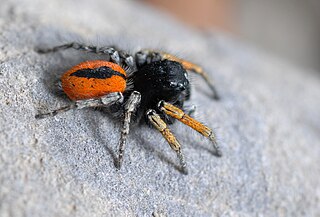
Philaeus chrysops is a species of jumping spider (Salticidae).
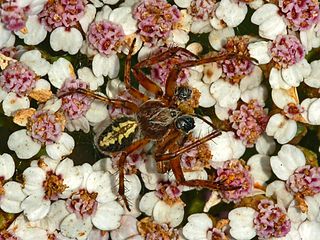
Aculepeira ceropegia, the oak spider, is an orb-weaving spider species belonging to the family Araneidae.

Tegenaria parietina is a rather rare spider in Europe, with a distribution also including Northern Africa to Central Asia and Sri Lanka, and from the West Indies to Uruguay and Argentina, where it may be introduced. In the UK it is sometimes known as the cardinal spider because of the legend that Cardinal Wolsey was terrified by this species at Hampton Court, or, conversely, because he regarded them as lucky and forbade anyone to harm them. In 2013, Tegenaria taprobanica was included in this species.
Alopecosa accentuata is a species of wolf spider found commonly in open habitats throughout continental Europe with a reported palearctic distribution. The female has a body length of up to 12 mm, the male is rather smaller at up to 9 mm. Some sources have the binomial as nomem dubium, with some shared characteristics with A. barbipes and A. farinosa.

Neriene peltata is a species of spider belonging to the family Linyphiidae. It has a Holarctic distribution.
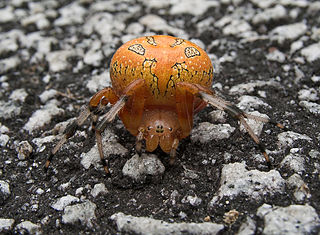
Araneus marmoreus, commonly called the marbled orb-weaver, is a species of spider belonging to the family Araneidae. It is sometimes also called the pumpkin spider from the resemblance of the female's inflated abdomen to an orange pumpkin. It has a Holarctic distribution.

Titanoeca quadriguttata is a species of spider in the family Titanoecidae. It is widespread in Europe, though absent from Great Britain, and is found in Austria, Belgium, Bulgaria, Corsica, Croatia, Czech Republic, France, Germany, Greece, Hungary, Italy, Liechtenstein, Moldova, Russia, Slovakia, Spain, Switzerland, the Netherlands, Ukraine.

Agalenatea redii is a species of 'orbweavers' belonging to the family Araneidae subfamily Araneinae.

Synema globosum is a species of spiders belonging to the family Thomisidae. It is sometimes called the Napoleon spider, because of a supposed resemblance of the markings on the abdomen to a silhouette of Napoleon wearing his iconic hat.
Attulus caricis is a species of spider in the family Salticidae. It has a Palearctic distribution, including Britain. Until 2017, it was placed in the genus Sitticus.

Attulus inexpectus is a species of spider from family Salticidae, found in from Europe to central Asia. It was previously misidentified as Attulus rupicola.

Scotophaeus blackwalli, also known as the mouse spider, is a species of spider belonging to the family Gnaphosidae.
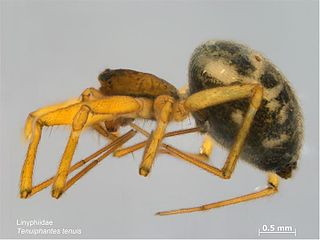
Tenuiphantes tenuis is a species of spider belonging to the family Linyphiidae. Its native distribution is reported as Europe, Macaronesia, Northern Africa, Turkey, Caucasus, Central Asia. The species was introduced to USA, Chile, Argentina and New Zealand from Europe where it is found throughout.
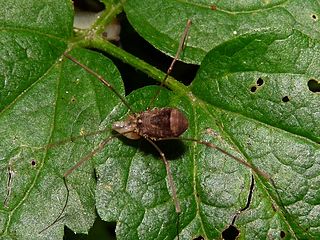
Leiobunum blackwalli is a species of harvestman. It is found in Europe.

Dictyna arundinacea is a species of spider belonging to the family Dictynidae. It has a holarctic distribution; It is found throughout Britain and northern Europe.

Lepthyphantes minutus is a species of spider belonging to the family Linyphiidae. Despite its name it is one of the larger species of Lepthyphantes. It is found throughout Northern Europe.

Ebrechtella tricuspidata is a species of crab spiders belonging to the family Thomisidae.


















